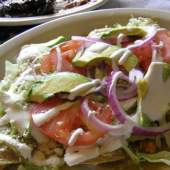Poland

Not long ago, Chicago was home to more citizens of Polish descent than Warsaw, attracted here beginning in the mid-19th century by the city’s booming industries and opportunities for independence and growth. The Polish community is still one of Chicago’s largest and most prominent, at last count making up just over seven percent of the population. The number of Polish speakers in the area is second only to English and Spanish, and Poland’s cultural presence in the city is remarkably strong and vibrant, through its many festivals, churches, and museum.
In honor of three upcoming events — Casimir Pulaski Day, which honors the Polish Revolutionary War hero; the birthday of beloved Polish composer Frédéric Chopin; and Fat Tuesday (which means just one thing: pączki!) — here is a closer look at Polish cuisine.
Like so many other countries, what Poles eat has been heavily influenced by its neighboring countries, which include the Czech Republic, Germany, Lithuania, Belarus, Slovakia, Ukraine, and even nearby Denmark, along with Poland’s Jewish population. Because of that, when dining at a Polish restaurant, you might find anything from schnitzel to stroganoff to latkes to crepes. And like comfort food, it’s best to leave your calorie counter at home, as a typical multi-course meal tends to be robust and includes a considerable amount of meat, especially pork sausage, and bread.
Here are a few elements of Polish cuisine with which Chicagoans are, perhaps, most familiar:
- Pierogi: These tasty dumplings (generally about the size of large ravioli or small eggrolls, take your pick) made from pockets of unleavened dough can be filled with almost anything from mushrooms, spinach, and potatoes, to fruit, to various meats, and are often served with…
- Sauerkraut: Chopped or shredded cabbage that is “fermented in vinegar and sometimes white wine,” according to the Urban Dictionary. As you might expect, the Poles got this from their German neighbors, and it’s often cooked together with potatoes and…
- Kielbasa: The name means, literally “sausage,” and there are a number of kinds. In Chicago, most hot dog stands also offer Polish sausage, which is generally more substantial than your standard frankfurter. Usually, though, Kielbasa is composed of pork, is sometimes smoked, contains garlic and other spices, and is often served with pickled cucumbers/gherkins or fried onions. These go well with beer (and vodka), and can be enjoyed hot or cold, boiled, baked, grilled, fried, or included in…
- Zupa (or Paćka or Papka): Soup. Beetroot is popular, along with other more tangy varieties, including sour rye, sour cabbage, and sour cucumber. Some have sour cream added, a custom that surely must have come from Ukraine. A frequent companion to soup is…
- Placki ziemniaczane: These are, simply, potato pancakes (or latkes). Some restaurants offer pancakes made from zucchini as a lighter alternative. In general, in a Polish eatery, you will find potatoes prepared in a wide variety of ways, and/or incorporated into classic Polish dishes.
How about dessert? Here are a few…
-
Kolaczki: These little cookies (pronounced koh-LOTCH-key) are especially popular in the United States; essentially, they are a bite-sized buttery pastry dusted with powdered sugar with a small dollop of fruit filling (cherry, apricot, strawberry) in the center. The savory version of this is klobasnek, with fillings ranging from cheese, meat, eggs, and peppers. For some reason, these are a big thing in Texas, which was an early destination for Polish immigrants, and are reminiscent of “pigs in a blanket.”
Kolaczki - Pączki: These round, decadent, filled doughnuts (pronounced POONCH-key) are everywhere on Fat Tuesday, the day before the beginning of Lent, and no self-respecting Polish bakery would be without them, including and especially Chicago. Fillings include fruit, chocolate, Bavarian cream, and two traditional jams: rose hip and plum. If custom or religion dictates that you give up something for Lent, this is an excellent candidate, so enjoy them while you can! Hint: this year, Fat Tuesday is February 28, and you can find pączki all around the city and suburbs.
By the way, after he moved to Vienna, Frédéric Chopin often yearned for food from his homeland, and his favorite was “zrazy, a Polish dish made of thin slices of chopped beef and stuffed with vegetables and eggs,” according to Classical-music.
No word on what Casimir Pulaski liked, so you might as well have a pączki (or two) in his honor. Not that you need another excuse!





